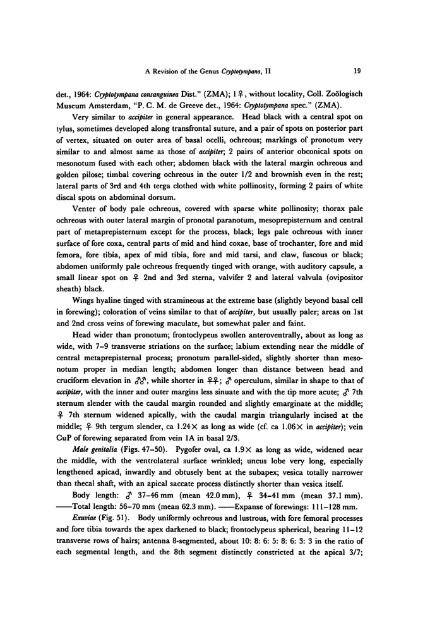A Revision of the Genus Cryptotympana (Homoptera, Cicadidae)
A Revision of the Genus Cryptotympana (Homoptera, Cicadidae)
A Revision of the Genus Cryptotympana (Homoptera, Cicadidae)
Create successful ePaper yourself
Turn your PDF publications into a flip-book with our unique Google optimized e-Paper software.
A <strong>Revision</strong> <strong>of</strong> <strong>the</strong> <strong>Genus</strong> <strong>Cryptotympana</strong>, II 19det., 1964: <strong>Cryptotympana</strong> consanguinea Dist." (ZMA); 1£, without locality, Coll. ZoologischMuseum Amsterdam, "P. C. M. de Greeve det., 1964: <strong>Cryptotympana</strong> spec." (ZMA).Very similar to accipiter in general appearance. Head black with a central spot ontylus, sometimes developed along transfrontal suture, and a pair <strong>of</strong>spots on posterior part<strong>of</strong> vertex, situated on outer area <strong>of</strong> basal ocelli, ochreous; markings <strong>of</strong> pronotum verysimilar to and almost same as those <strong>of</strong> accipiter, 2 pairs <strong>of</strong> anterior obconical spots onmesonotum fused with each o<strong>the</strong>r; abdomen black with <strong>the</strong> lateral margin ochreous andgolden pilose; timbal covering ochreous in <strong>the</strong> outer 1/2 and brownish even in <strong>the</strong> rest;lateral parts <strong>of</strong> 3rd and 4th terga clo<strong>the</strong>d with white pollinosity, forming 2 pairs <strong>of</strong> whitediscal spots on abdominal dorsum.Venter <strong>of</strong> body pale ochreous, covered with sparse white pollinosity; thorax paleochreous with outer lateral margin <strong>of</strong> pronotal paranotum, mesoprepisternum and centralpart <strong>of</strong> metaprepisternum except for <strong>the</strong> process, black; legs pale ochreous with innersurface <strong>of</strong> fore coxa, central parts <strong>of</strong>mid and hind coxae, base <strong>of</strong> trochanter, fore and midfemora, fore tibia, apex <strong>of</strong> mid tibia, fore and mid tarsi, and claw, fuscous or black;abdomen uniformly pale ochreous frequently tinged with orange, with auditory capsule, asmall linear spot on -°- 2nd and 3rd sterna, valvifer 2 and lateral valvula (ovipositorsheath) black.Wings hyaline tinged with stramineous at <strong>the</strong> extreme base (slightly beyond basal cellin forewing); coloration <strong>of</strong> veins similar to that <strong>of</strong> accipiter, but usually paler; areas on 1stand 2nd cross veins <strong>of</strong> forewing maculate, but somewhat paler and faint.Head wider than pronotum; frontoclypeus swollen anteroventrally, about as long aswide, with 7-9 transverse striations on <strong>the</strong> surface; labium extending near <strong>the</strong> middle <strong>of</strong>central metaprepisternal process; pronotum parallel-sided, slightly shorter than mesonotum proper in median length; abdomen longer than distance between head andcruciform elevation in ff, while shorter in £•?-; f operculum, similar in shape to that <strong>of</strong>accipiter, with <strong>the</strong> inner and outer margins less sinuate and with <strong>the</strong> tip more acute; f 7thsternum slender with <strong>the</strong> caudal margin rounded and slightly emarginate at <strong>the</strong> middle;•°- 7th sternum widened apically, with <strong>the</strong> caudal margin triangularly incised at <strong>the</strong>middle; £ 9th tergum slender, ca 1.24X as long as wide (cf. ca 1.06X in accipiter); veinCuP <strong>of</strong> forewing separated from vein 1A in basal 2/3.Male genitalia (Figs. 47-50). Pyg<strong>of</strong>er oval, ca 1.9X as long as wide, widened near<strong>the</strong> middle, with <strong>the</strong> ventrolateral surface wrinkled; uncus lobe very long, especiallyleng<strong>the</strong>ned apicad, inwardly and obtusely bent at <strong>the</strong> subapex; vesica totally narrowerthan <strong>the</strong>cal shaft, with an apical saccate process distinctly shorter than vesica itself.Body length: f 37-46 mm (mean 42.0 mm), £ 34-41 mm (mean 37.1mm).Total length: 56-70 mm (mean 62.3 mm). Expanse <strong>of</strong> forewings: 111-128 mm.Exuviae (Fig. 51). Body uniformly ochreousand lustrous, with fore femoral processesand fore tibia towards <strong>the</strong> apex darkened to black; frontoclypeus spherical, bearing 11-12transverse rows <strong>of</strong> hairs; antenna 8-segmented, about 10: 8: 6: 5: 8: 6: 3: 3 in <strong>the</strong> ratio <strong>of</strong>each segmental length, and <strong>the</strong> 8th segment distinctly constricted at <strong>the</strong> apical 3/7;
















